Fiberglass Mat Tissue - Glass Fiber Chop Strand Mat Rolls, Fiberglass Mat
- Loading Port:
- China main port
- Payment Terms:
- TT OR LC
- Min Order Qty:
- 1.5
- Supply Capability:
- 100 m.t/month
OKorder Service Pledge
OKorder Financial Service
You Might Also Like
Glass Fiber Chopped Strand Mat Rolls, Fiberglass Mat
Introduction:
Fiberglass chopped strand mat is a non-woven E-or C-glassfiber mat, product manufactured by spreading continuous filament roving of 50mm in length randomly and uniformly in combination with polyester binder in powder form (or other binder in emulsion from). This product is characterized by good combination of resin, easy operation, good wet strength retention, good laminate transparency and low cost. It is suitable for the applications of hand lay-up FRP moldings, such as various sheets and panels, boat hulls, bath tubs, cooling towers, corrosion resistant, vehicles etc.
Function:
Fiberglass chopped strand mat is chopped using the "E" chopped glass and emulsion adhesive bond. It is suitable for hand lay and can enhance the unsaturaed ployester resins.
Product Features:
Consistent thickness and stiffness;
Rapid impregnating and good compatibility with resin;
Superior wet through with less air trap;
Good mechanical properties and high strength of parts.
Superior acid corrosion resistance
Technical Data:










FAQ:
Is sample available ?
Yes, we provide the free samples, but customers themselves need pay the shipping fee
What's your MOQ?
Our MOQ is one 1*20' full container loading
How do you pack the fiberglass
(1) First, the mat is in roll packed in White PE fIlm.
(2) Then the rolls packed in the carton
- Q: Can fiberglass mat tissue be used for architectural sculptures?
- Certainly! Fiberglass mat tissue is an ideal choice for architectural sculptures. This versatile material finds extensive use across various applications, including the creation of architectural sculptures. Renowned for its lightweight nature, flexibility, and exceptional strength and durability properties, it proves itself as an excellent option for crafting intricate and detailed sculptures. The beauty of fiberglass mat tissue lies in its ability to be molded and shaped into various forms, enabling artists and sculptors to transform their creative visions into reality. Regardless of the sculpture's size or shape, this material allows for utmost creativity, whether it be a small decorative piece or a large-scale installation. Moreover, fiberglass mat tissue boasts resistance against adverse weather conditions and environmental elements, rendering it suitable for outdoor sculptures. Its capacity to withstand extreme temperature fluctuations, UV radiation, and moisture ensures the sculptures' integrity and aesthetic appeal remain unscathed for an extended period. To further enhance the desired aesthetic appearance, fiberglass mat tissue can be effortlessly painted and finished. The material readily accepts various paints, varnishes, or finishes, providing artists with the means to elevate the visual appeal and safeguard the sculpture's surface against potential damage. All in all, fiberglass mat tissue serves as a reliable and versatile medium for artists and sculptors alike to create architectural sculptures. Its robustness, durability, and adaptability make it an exceptional choice for translating artistic visions into tangible masterpieces within the realm of architecture.
- Q: Can fiberglass mat tissue be used for electrical transformers?
- Fiberglass mat tissue can be used for electrical transformers. It is commonly used as insulation material in transformer manufacturing due to its excellent electrical insulation properties. Fiberglass mat tissue is made of fine glass fibers bonded together with a resin, creating a strong and durable material. It is able to withstand high temperatures and has a high dielectric strength, making it suitable for use in electrical transformers. Additionally, fiberglass mat tissue is lightweight and flexible, allowing for easy handling and installation in transformer components. It is also resistant to moisture, chemicals, and fire, further enhancing its suitability for transformer applications. Overall, fiberglass mat tissue is a reliable and efficient choice for insulation in electrical transformers.
- Q: How does fiberglass mat tissue perform in terms of chemical resistance?
- Fiberglass mat tissue is renowned for its exceptional chemical resistance capabilities. This material is typically composed of glass fibers held together by a binder, enabling it to withstand a wide range of chemicals. This makes it a popular choice as a reinforcement in composite materials, like fiberglass-reinforced plastics (FRP), as it can endure exposure to various chemicals without degradation. The level of chemical resistance in fiberglass mat tissue can vary depending on its specific type, quality, and the chemicals it encounters. However, it generally exhibits high resistance to acids, alkalis, solvents, and other corrosive substances. This quality makes it suitable for applications where the material may come into contact with aggressive chemicals, such as in chemical processing plants, water treatment facilities, or storage tanks. It is important to acknowledge that while fiberglass mat tissue is generally chemically resistant, it may not be completely impervious to all chemicals. Certain highly concentrated or specialized chemicals may still have the potential to cause damage or deterioration over time. Therefore, it is always advisable to consult the manufacturer's specifications and recommendations for detailed information on chemical resistance before utilizing fiberglass mat tissue in a particular application. All in all, fiberglass mat tissue's robust chemical resistance properties establish it as a dependable option for applications involving chemical exposure.
- Q: Is fiberglass mat tissue suitable for automotive body panel repairs?
- Indeed, automotive body panel repairs can be successfully carried out using fiberglass mat tissue. This material, known for its robustness, endurance, and adaptability, is widely employed in automotive repairs. Its exceptional ability to conform to the distinctive curves of a vehicle makes it particularly effective in fixing body panels. Moreover, fiberglass mat tissue boasts resistance against corrosion, moisture, and chemicals, rendering it a prime selection for automotive purposes. Furthermore, its lightweight nature aids in reducing the overall weight of the vehicle, thereby enhancing fuel efficiency. All in all, fiberglass mat tissue proves to be a dependable and efficient choice for automotive body panel repairs.
- Q: Is fiberglass mat tissue suitable for insulation in data centers?
- Fiberglass mat tissue can be suitable for insulation in data centers, depending on specific requirements and considerations. Fiberglass mat tissue is a type of fiberglass insulation that is commonly used for thermal and acoustic insulation purposes. It offers several advantages such as high thermal resistance, fire resistance, and sound absorption capabilities. In data centers, insulation plays a crucial role in maintaining a controlled and stable environment for the sensitive electronic equipment. Fiberglass mat tissue can help in reducing heat transfer, preventing the occurrence of hot spots, and maintaining the desired temperature levels within the data center. It can also contribute to noise reduction, which is important in reducing distractions and ensuring a comfortable working environment for the personnel. However, there are certain factors that need to be considered before determining the suitability of fiberglass mat tissue for insulation in data centers. Firstly, the specific requirements of the data center in terms of thermal insulation, fire resistance, and acoustic control should be thoroughly evaluated. Additionally, the installation process and maintenance requirements should be assessed to ensure that the insulation material can be effectively implemented and maintained in the data center's infrastructure. It is also important to consider alternative insulation options such as mineral wool, foam insulation, or other specialized materials that may better suit the unique demands of data centers. These materials might offer specific advantages like better fire resistance, moisture control, or higher thermal efficiency. Ultimately, the suitability of fiberglass mat tissue for insulation in data centers depends on a comprehensive evaluation of the specific needs, regulatory requirements, and available options. Consulting with experts in the field of data center construction and insulation can provide valuable insights and help in making an informed decision.
- Q: What are the different surface textures available for fiberglass mat tissue?
- Some of the different surface textures available for fiberglass mat tissue include smooth, coarse, textured, embossed, and patterned.
- Q: Is fiberglass mat tissue suitable for construction applications?
- Indeed, fiberglass mat tissue proves to be a fitting material for construction purposes. Renowned for its robustness, longevity, and ability to withstand diverse environmental conditions, this versatile substance is frequently employed in roofing, flooring, insulation, and wall panel installations. Fiberglass mat tissue emerges as an exceptional selection for construction ventures as it bestows reinforcement and stability upon a range of materials. When incorporated into roofing materials, it fortifies them against impacts, weathering, and fires. Similarly, it bolsters the strength and durability of flooring systems, rendering them capable of withstanding substantial loads and heavy foot traffic. Moreover, fiberglass mat tissue exhibits commendable insulation capabilities. It serves as an efficacious insulating component for walls, ceilings, and floors, enabling the maintenance of a comfortable indoor temperature while diminishing energy consumption. Its thermal and acoustic insulation properties render it an ideal choice for construction applications. Furthermore, its imperviousness to moisture, chemicals, and corrosion makes fiberglass mat tissue a suitable option for deployment in areas characterized by high humidity or exposure to harsh chemicals. Thanks to its resistance to decay, it guarantees durability, ensuring longevity in construction projects. To conclude, fiberglass mat tissue is an apt choice for construction applications due to its strength, durability, insulation properties, and resistance to various environmental factors. Its adaptability and reliability have cemented its popularity within the construction industry.
- Q: Is fiberglass mat tissue resistant to UV radiation?
- Yes, fiberglass mat tissue is resistant to UV radiation. Fiberglass is known for its excellent resistance to UV rays, making it highly suitable for outdoor applications. UV radiation from the sun can cause materials to degrade, discolor, or become brittle over time. However, fiberglass mat tissue is made with a special resin that provides UV stability, allowing it to maintain its strength and integrity even when exposed to sunlight for extended periods. This makes fiberglass mat tissue a popular choice for various outdoor applications such as roofing, boat construction, and exterior cladding, where it is essential to have a material that can withstand the damaging effects of UV radiation.
- Q: Is fiberglass mat tissue suitable for automotive interiors?
- Yes, fiberglass mat tissue is suitable for automotive interiors. It is commonly used as a reinforcement material in automotive parts and can provide strength, durability, and improved acoustic performance. Additionally, fiberglass mat tissue is lightweight and easy to mold, making it a practical choice for various interior components such as door panels, headliners, and trunk liners.
- Q: Is fiberglass mat tissue suitable for automotive applications?
- Yes, fiberglass mat tissue is suitable for automotive applications. Fiberglass mat tissue is a versatile material that offers numerous benefits when used in automotive applications. It provides excellent strength and durability, which is essential for automotive parts that need to withstand harsh conditions and heavy usage. Fiberglass mat tissue also has good thermal and electrical insulation properties, making it suitable for applications where temperature resistance and electrical insulation are required. Additionally, fiberglass mat tissue is lightweight, which can help improve fuel efficiency and overall vehicle performance. It is also easy to mold and shape, allowing manufacturers to create complex automotive parts with precision. Furthermore, fiberglass mat tissue is resistant to corrosion, chemicals, and UV radiation, ensuring the longevity and reliability of automotive components. Overall, the unique properties of fiberglass mat tissue make it an ideal choice for various automotive applications, including but not limited to body panels, interior components, structural reinforcements, and sound insulation. Its strength, durability, insulation properties, lightweight nature, and resistance to corrosion and chemicals make it a reliable and cost-effective material for the automotive industry.
Send your message to us
Fiberglass Mat Tissue - Glass Fiber Chop Strand Mat Rolls, Fiberglass Mat
- Loading Port:
- China main port
- Payment Terms:
- TT OR LC
- Min Order Qty:
- 1.5
- Supply Capability:
- 100 m.t/month
OKorder Service Pledge
OKorder Financial Service
Similar products
Hot products
Hot Searches
Related keywords

































